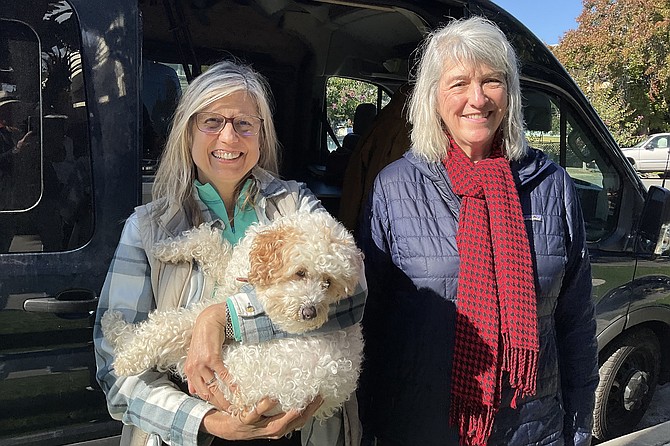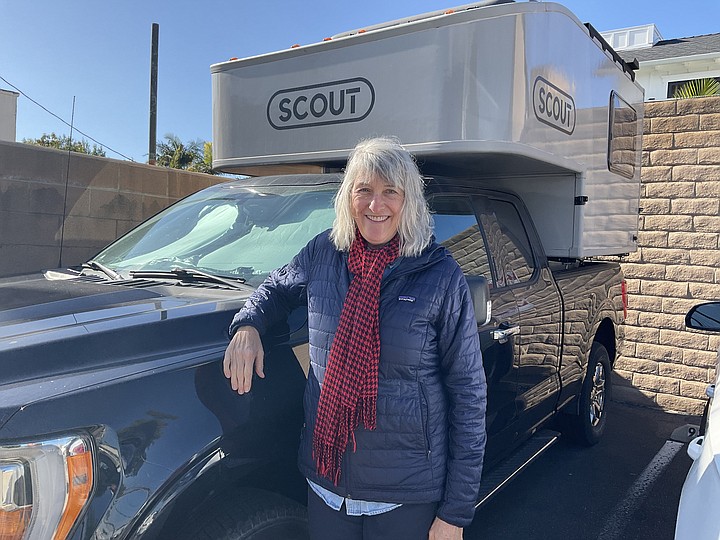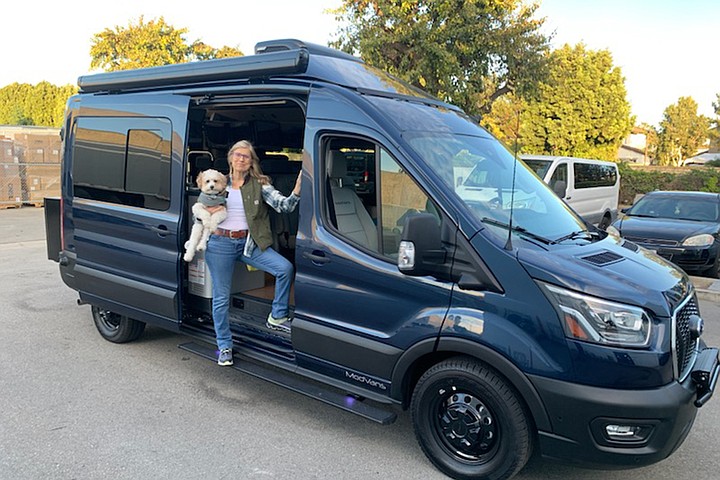 Facebook
Facebook
 X
X
 Instagram
Instagram
 TikTok
TikTok
 Youtube
Youtube

What are the odds? Two women sitting next to each other. Strangers. They introduce themselves.
“Hi. I’m Mary Beth.”
“Well actually, I’m Mary Beth.”
Turns out they’re both Mary Beth. And that’s just the start: they have each been widowed, and each subsequently made a decision to break out, buy a truck camper, and hit the road. Become solo women road warriors, living out what had originally been a dream they shared with their husbands.
I’m meeting on a weekend morning with my good Scottish buddy Anni Klapka — also widowed, also active — and the two Mary Beths, to talk about the ups and downs that “unaccompanied” women encounter when they take to the open road. And take to it they have: MaryBeth the wellness counselor has driven the northeast and the West Coast. Mary Beth the retired SDSU nursing prof has trekked through Florida and up to Canada, with all points between, sleeping in a camper in strange parking lots, visiting desert campsites.
“You are so brave, going out on trips like these alone,” says Anni to them. “I think it’s wonderful. But for someone like me, I’d have to know there were stop-off places every two or three miles where they were checking my tires, checking my speed, checking my water, checking my everything. If I could follow the Mary Beths in convoy, I would tear around behind them like a puppy dog!”
For the two Mary Beths, that decision to bust out of the isolation of widowhood and just go hit the road meant buying wagons. In Mary Beth Parr’s case, it was a Scout camper, which piggybacks onto her Ford F-150 truck. Cost her about $25,000. MaryBeth Pappas Baun spent around $150,000, including customization, on a ModVan based on a Ford Transit.

“Why do I do this? Well, I’ve been camping pretty much my whole life,” says Mary Beth Parr. “My husband and I backpacked. Then we got a pop-up tent trailer, then a bigger one, and then he passed away, and I had to sell the camper. But I still wanted to camp. I came across the Scout camper online, and bought it sight unseen. Then a month later, I got the truck, drove up to Oregon to pick up the Scout, and since then, it’s been 30,000 miles of moving everywhere on the road. I love it. ”
But what about the safety of a woman alone? “I went to an expo in May of 2021 in Flagstaff, Arizona,” says Parr. “Got talking about safety. Things like, who’s out there around you when you’re camping? And the expo people were like, ‘Oh, you need a gun.’ And I said, ‘I don’t know if I could shoot anybody.’ It comes down to this: as a nurse, I work to help people. So what can I have for safety? I have bear spray, which I can use as a weapon. I have a small taser. I have my keys to my car, which will send out an alarm. And I try to make it so people don’t know that it’s just a woman in there camping.”
“You put a blow-up dummy in the car,” pipes in Scottish Anni. “You put a hat on it and make it look like it’s a man. You sit it in the passenger seat, and you talk to it.”
“But knock on wood and say my prayers, I’ve never had any issues where I’ve been afraid,” continues Parr. “At one place in Arizona, I didn’t feel comfortable, so I left a day early and I went on to the Vulture Mine, to Kofa, the King of Arizona mines. I was up there by myself too, but didn’t have any issues. I think you can have more problems when you’re around people, or if you camp someplace where you’re thinking like, ‘Should I really be camping here?’ But mostly, people appreciate seeing a woman do this. The only ones who don’t are my friends back home, who are like, ‘We don’t know where you are.’ So now I have an Apple Airtag, and if I’m going to be out of reach, I have a Garmin Mini, and you can push a button on it like an SOS. But I haven’t had anybody making me feel uncomfortable. And if I do, I can always go in and lock the door. So many people advise me to carry a firearm. The trouble is, you can’t take it into Canada. Other people say I should have a dog. I’m like, ‘Well, a dog would be good, but you can’t take your dog into national parks.’”

Often, you can be parked close to comfortable housing but still be living, essentially, on the street. You do have to be adaptable. “My worst experience,” says MaryBeth Pappas Baun, “was when I ran out of propane up in the mountains. My electricity died. It got really, really cold. My friend” — a lady who lived near where she was parked — “later said ‘Why didn’t you come into my house?’ I said, ‘I didn’t want to disturb you.’ So I started the car with the idea of finding an all-night propane place. But when you start the car, the battery recharges. So I just turned on the heat, put the passenger seat into recline, put Auggie the dog on my lap, flung the blanket over me, and curled over and went to sleep. That’s a good thing about the Transit. It idles on a very, very low level and uses almost no gas.”
“My worst experience?” says Mary Beth Parr. “I’d have to say camping in a high wind. Like, up in the desert, near Ridgecrest. Just me and those winds. Rock and roll! That and motorcycles buzzing by at six in the morning. But I didn’t feel scared. I was just like, ‘I want to go to sleep.’”
Best experiences, they agree, usually involve camping somewhere bucolic, far from the crowds. Mary Beth Parr’s? “Dillon, Montana. Waking up beside a beautiful, peaceful, quiet creek. That’s what this is all about.”
“I wish I had the guts to do this,” says Anni Klapka again. “All I’ve got is the money. Think I’ll stick to cruise ships.”


What are the odds? Two women sitting next to each other. Strangers. They introduce themselves.
“Hi. I’m Mary Beth.”
“Well actually, I’m Mary Beth.”
Turns out they’re both Mary Beth. And that’s just the start: they have each been widowed, and each subsequently made a decision to break out, buy a truck camper, and hit the road. Become solo women road warriors, living out what had originally been a dream they shared with their husbands.
I’m meeting on a weekend morning with my good Scottish buddy Anni Klapka — also widowed, also active — and the two Mary Beths, to talk about the ups and downs that “unaccompanied” women encounter when they take to the open road. And take to it they have: MaryBeth the wellness counselor has driven the northeast and the West Coast. Mary Beth the retired SDSU nursing prof has trekked through Florida and up to Canada, with all points between, sleeping in a camper in strange parking lots, visiting desert campsites.
“You are so brave, going out on trips like these alone,” says Anni to them. “I think it’s wonderful. But for someone like me, I’d have to know there were stop-off places every two or three miles where they were checking my tires, checking my speed, checking my water, checking my everything. If I could follow the Mary Beths in convoy, I would tear around behind them like a puppy dog!”
For the two Mary Beths, that decision to bust out of the isolation of widowhood and just go hit the road meant buying wagons. In Mary Beth Parr’s case, it was a Scout camper, which piggybacks onto her Ford F-150 truck. Cost her about $25,000. MaryBeth Pappas Baun spent around $150,000, including customization, on a ModVan based on a Ford Transit.

“Why do I do this? Well, I’ve been camping pretty much my whole life,” says Mary Beth Parr. “My husband and I backpacked. Then we got a pop-up tent trailer, then a bigger one, and then he passed away, and I had to sell the camper. But I still wanted to camp. I came across the Scout camper online, and bought it sight unseen. Then a month later, I got the truck, drove up to Oregon to pick up the Scout, and since then, it’s been 30,000 miles of moving everywhere on the road. I love it. ”
But what about the safety of a woman alone? “I went to an expo in May of 2021 in Flagstaff, Arizona,” says Parr. “Got talking about safety. Things like, who’s out there around you when you’re camping? And the expo people were like, ‘Oh, you need a gun.’ And I said, ‘I don’t know if I could shoot anybody.’ It comes down to this: as a nurse, I work to help people. So what can I have for safety? I have bear spray, which I can use as a weapon. I have a small taser. I have my keys to my car, which will send out an alarm. And I try to make it so people don’t know that it’s just a woman in there camping.”
“You put a blow-up dummy in the car,” pipes in Scottish Anni. “You put a hat on it and make it look like it’s a man. You sit it in the passenger seat, and you talk to it.”
“But knock on wood and say my prayers, I’ve never had any issues where I’ve been afraid,” continues Parr. “At one place in Arizona, I didn’t feel comfortable, so I left a day early and I went on to the Vulture Mine, to Kofa, the King of Arizona mines. I was up there by myself too, but didn’t have any issues. I think you can have more problems when you’re around people, or if you camp someplace where you’re thinking like, ‘Should I really be camping here?’ But mostly, people appreciate seeing a woman do this. The only ones who don’t are my friends back home, who are like, ‘We don’t know where you are.’ So now I have an Apple Airtag, and if I’m going to be out of reach, I have a Garmin Mini, and you can push a button on it like an SOS. But I haven’t had anybody making me feel uncomfortable. And if I do, I can always go in and lock the door. So many people advise me to carry a firearm. The trouble is, you can’t take it into Canada. Other people say I should have a dog. I’m like, ‘Well, a dog would be good, but you can’t take your dog into national parks.’”

Often, you can be parked close to comfortable housing but still be living, essentially, on the street. You do have to be adaptable. “My worst experience,” says MaryBeth Pappas Baun, “was when I ran out of propane up in the mountains. My electricity died. It got really, really cold. My friend” — a lady who lived near where she was parked — “later said ‘Why didn’t you come into my house?’ I said, ‘I didn’t want to disturb you.’ So I started the car with the idea of finding an all-night propane place. But when you start the car, the battery recharges. So I just turned on the heat, put the passenger seat into recline, put Auggie the dog on my lap, flung the blanket over me, and curled over and went to sleep. That’s a good thing about the Transit. It idles on a very, very low level and uses almost no gas.”
“My worst experience?” says Mary Beth Parr. “I’d have to say camping in a high wind. Like, up in the desert, near Ridgecrest. Just me and those winds. Rock and roll! That and motorcycles buzzing by at six in the morning. But I didn’t feel scared. I was just like, ‘I want to go to sleep.’”
Best experiences, they agree, usually involve camping somewhere bucolic, far from the crowds. Mary Beth Parr’s? “Dillon, Montana. Waking up beside a beautiful, peaceful, quiet creek. That’s what this is all about.”
“I wish I had the guts to do this,” says Anni Klapka again. “All I’ve got is the money. Think I’ll stick to cruise ships.”
Comments